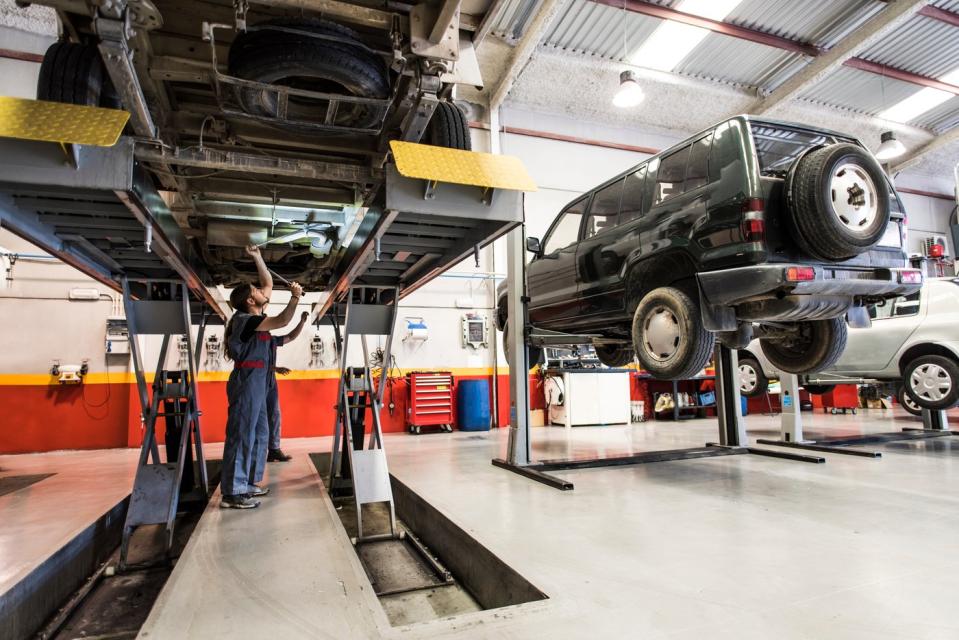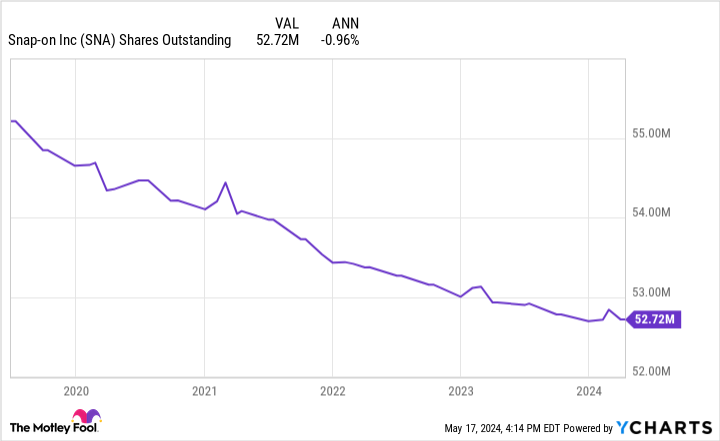Founded 103 years ago, Snap-on (NYSE: SNA) has grown to become a vertically integrated behemoth selling tools, equipment, diagnostics, and repair solutions, primarily to automotive and industrial shops.
The mission-critical nature of Snap-on’s tools and its leadership position within its niche have combined to deliver total returns of around 11,500% since its initial public offering in 1972. The company has returned over 1,800%, since 2000, nearly quadrupling the S&P 500 index’s total returns.
Remarkably, despite this run, Snap-on’s slow-and-steady growth potential remains as promising as ever — yet the company’s valuation remains well below market averages. Here’s the case for buying and holding this multibagger forever at today’s attractive prices.
Snap-on empowers mechanics and technicians globally
Snap-on sells over 70,000 tools in more than 130 countries, operating through the following four business segments:
-
Snap-on tools (37% of 2023 sales): Anchoring this unit are Snap-on’s franchised mobile vans, which travel the world, bringing tools (such as wrenches, sockets, screwdrivers, and power tools) to mechanics in the vehicle service and repair industry.
-
Repair systems and information (31% of sales): This segment sells computer-based diagnostic equipment, diagnostic software solutions, service and repair information, and software to help with shops’ daily operations.
-
Commercial and industrial (26% of sales): This unit provides heavy-duty and custom-built tools and equipment for customers in industries such as aviation, the military, agriculture, mining, and advanced manufacturing.
-
Financial services (6% of sales): The company’s smallest unit supports big-ticket purchases made by technicians and shop owners, as well as Snap-on’s franchisees investing in their operations.
This diverse suite of tools, equipment, and diagnostics that serve essential industries has helped Snap-on grow sales and free cash flow (FCF) by 5% and 17% annually, respectively, over the last decade.
Regardless of these steady results, the market seems to remain worried about the company’s long-term viability as the automotive industry shifts toward hybrid and electric vehicles.
But CEO Nicholas Pinchuk believes these varying powertrains only add complexity to the automotive repair industry, meaning customers will need more of the company’s tools over the long haul. As vehicles continue to become increasingly compartmentalized, more and more pieces will need to be removed in order to reach the mechanical part that is causing this issue.
Simply put, this ongoing automotive transformation should only help (rather than disrupt) Snap-on over time, especially as the company continues to work alongside original equipment manufacturers.

Snap-on’s best-in-class profitability
With a return on invested capital (ROIC) of 17%, Snap-on has a long history of delivering high profitability in comparison to its debt and equity. This ROIC is vital for the Snap-on’s shareholders because it highlights the company’s ability to profitably build out its manufacturing capacity and innovate into new product verticals.
Historically, businesses with a high and rising ROIC have a history of delivering higher stock returns than their lower-ranked peers, as this linked article points out. Snap-on seems to fit this mold with an ROIC ranking in the top quartile among its S&P 500 peers.
In addition to this high ROIC, Snap-on holds a 20% net profit margin. This top-tier margin is indicative of a wide moat stemming from the pricing power of the company’s Snap-on brand and its vital products.
A growing dividend at a below-market valuation
Snap-on continues to trade at a deep discount to the broader market despite its stable sales, steady growth, and top-notch profitability. With a price-to-earnings (P/E) ratio of just 15 — compared to the S&P 500 index’s average of 25 — the company remains attractively valued.
Partly thanks to this discounted valuation, the company also pays an outsize 2.5% dividend yield, which is well ahead of the index’s average of just 1.4%. Snap-on’s payout ratio is a mere 36%, despite this superior yield, meaning that it uses only 36% of its net income to fund its dividend payments. This low payout ratio signals that the company has excess room to continue boosting its dividend far into the future, just like it has over the last decade, which saw annualized increases of 15%.
Besides these rising dividend payments, Snap-on has consistently repurchased 1% of its outstanding shares annually over the last five years, further juicing cash returns to shareholders and earnings-per-share figures.
The company’s blend of growth potential; exceptional profitability; and a large, growing, and well-funded dividend — all at a below-market price — combine to make Snap-on one of my favorite stocks to buy and hold forever.
Should you invest $1,000 in Snap-on right now?
Before you buy stock in Snap-on, consider this:
The Motley Fool Stock Advisor analyst team just identified what they believe are the 10 best stocks for investors to buy now… and Snap-on wasn’t one of them. The 10 stocks that made the cut could produce monster returns in the coming years.
Consider when Nvidia made this list on April 15, 2005… if you invested $1,000 at the time of our recommendation, you’d have $580,722!*
Stock Advisor provides investors with an easy-to-follow blueprint for success, including guidance on building a portfolio, regular updates from analysts, and two new stock picks each month. The Stock Advisor service has more than quadrupled the return of S&P 500 since 2002*.
*Stock Advisor returns as of May 13, 2024
Josh Kohn-Lindquist has no position in any of the stocks mentioned. The Motley Fool has no position in any of the stocks mentioned. The Motley Fool has a disclosure policy.
1 Magnificent Dividend Stock Up 1,830% Since 2000 to Buy and Hold Forever was originally published by The Motley Fool
Source Agencies



